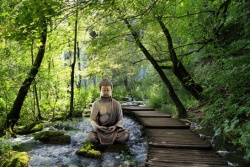Sanno-Ichijitsu Shinto
Doctrines
Sanno-ichijitsu Shinto (Mountain-king One-Reality Shinto) derives its doctrines from the Tendai sect of Buddhism, of which it formed a part.
Sanno Ichijitsu Shinto takes its name from the Mountain King deity (Sanno) who was believed to be the guardian of Mt Hiei, outside Kyoto, and therefore of the headquarters of the Tendai sect whose main monastic complex, Enryakuji, was located on the mountain. Sanno was regarded as a manifestation or avatar (Japanese: gongen) of the Buddha Shakyamuni.
History
According to legend Saicho or Dengyo Daishi (767-822) , founder of the Tendai sect in Japan was helped in his realisation of the true meaning of the Lotus Sutra by Sanno.
Although Sanno Ichijitsu Shinto traces its origins to Saicho, and Sanno was worshipped as the guardian of Mt Hiei and the Tendai sect at twenty-one shrines on Mt Hiei, the main proponent of Sanno Ichijitsu Shinto was the monk Tenkai or Jigen Daishi (1536-1643).
He achieved prominence for the sect when he secured the right to build the great mausoleum at Nikko to enshrine the spirit of the first Tokugawa shogun (Tokugawa Ieyasu) as a manifestation of the healing Buddha Yakushi.
All traces of the association between Tendai Buddhism and Shinto were expunged at the time of shinbutsu bunri (separation of kami and Buddhas) in 1868.
Nikko is now a Shinto shrine much-visited by tourists, with an annual ritual procession (sennin gyoretsu) of a thousand people in Tokugawa period costumes. The main Sanno shrine on Mt Hiei is the Hie Taisha, overlooking lake Biwa.
It has thousands of branch shrines known as Hie Jinja including one in Tokyo which is the protector shrine of the current imperial palace.
Symbols
The Nikko Toshogu is built in the richly decorative and much copied gongen-zukuri (avatar-style) with ornate lacquer work and wood carvings reflecting the ritual and artistic celebration of the cosmos characteristic of Tendai esotericism.
The shrine buildings of a gongen-style shrine are laid out in the shape of an H, representing Tendai ideas.
The Nikko Toshogu in its setting of giant trees is regarded by some as one of the most beautiful shrines in Japan.
Adherents No contemporary adherents
Headquarters/
Main Centre Hie Taisha, ([[Mt[Hiei]], Shiga Prefecture

